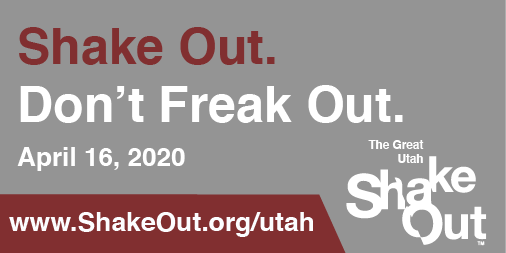Why we need an earthquake drill even after so many recent earthquakes

Good morning, Utah! We’ve always wondered if an earthquake would happen on the day of the ShakeOut. Well, here we are! There have been more than 1,200 aftershocks following the March 18 Magna earthquake. The most recent felt aftershock was an M4.2 today at 7:41 a.m.
With so many recent earthquakes, some have asked why we would still hold the annual Great Utah ShakeOut earthquake drill. Here’s why:
- It’s tradition: Since 2012, more than 7.6 million people have participated in earthquake drills.
- We need practice: Because the first Magna quake caught people off guard, not everyone responded appropriately.
- Reduce anxiety: Thousands of people have reported anxiety in the wake of the Magna quakes. Preparedness reduces anxiety.
How to get the most out of the ShakeOut during the COVID-19 pandemic
Plan for yourself
Person after person told us they got up and ran around during the Magna quake. They feared their house would fall down, or they wanted to run to their children. These actions are a normal stress response, but they put people in greater danger.
In the developed world, the majority of serious injuries and fatalities from earthquakes are caused by head trauma from people running around and falling, or from objects flying and crashing into people. Most buildings will not collapse. If you live in an old, unreinforced masonry home, check out the Utah Seismic Safety Commission’s retrofitting guide.
Our M5.7 quake might not have been strong enough to throw you to the ground, but a larger quake would. People would get their shoulders dislocated. They would get glass in their bare feet. Brick and stone building facades would crumble and fall on people if they ran outdoors.

Statistics show the safest thing for people to do is stay where they are. First order of business: Protect your body, and teach your family members to protect theirs.
- If it’s daytime, DROP to the ground, take COVER under something sturdy, and HOLD ON!
- If there’s nothing to get under, crouch near an interior wall and cover your head with your arms.
- If it’s nighttime, protect your head with a pillow and stay in bed!
- Keep sturdy shoes near beds to avoid glass shards in bare feet.
- Do a drill with kids: Shake their beds while they lie in them, so they know what to expect and know to stay put!
Plan for your stuff
- Do a hazard hunt. Walk around and note what objects are likely to go flying.
- Secure heavy furniture and TVs to walls.
- Strap water heaters to studs.
- Put latches on upper kitchen cabinets to prevent glasses and dishes from flying out.
- Remove heavy objects that could fall on beds (shelves, mirrors, armoires).
- Make a disaster kit.
- Add to food and water storage.
Plan for your information
We found out during the Magna quake that rumors and misinformation compounded everyone’s stress. People reacted out of fear and possibly an innate need to be part of the conversation. Within only a few minutes, falsehoods spread across the entire state.
Teach your family they MUST NOT post, tweet, text, or share information without verifying it.
The following are excellent sources of immediate earthquake information on Twitter in a pinch:
- Utah Division of Emergency Management
- University of Utah Seismograph Stations
- Utah Geological Survey
- Be Ready Utah
- For more in-depth information, click on the websites for the interagency partners at the bottom of the page.
Joe Dougherty is the public information officer for the Utah Division of Emergency Management. [email protected].
